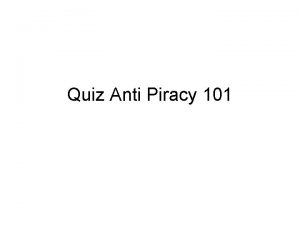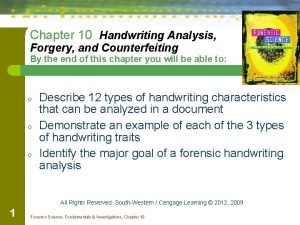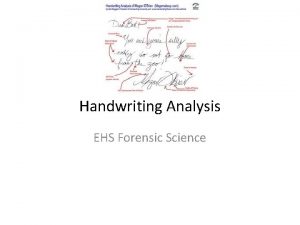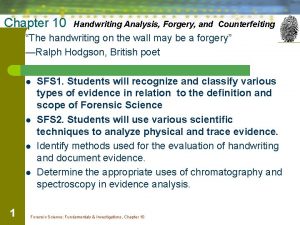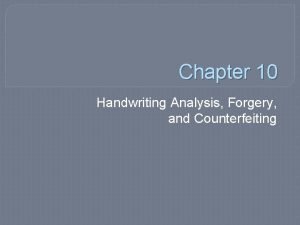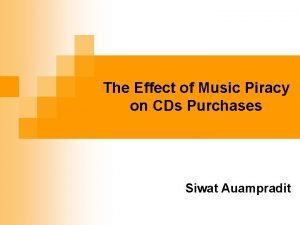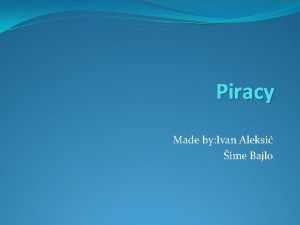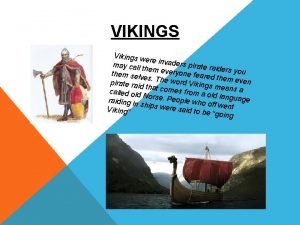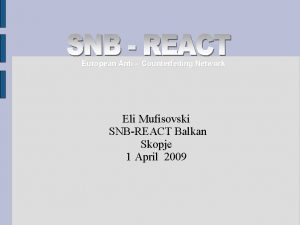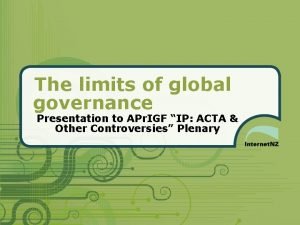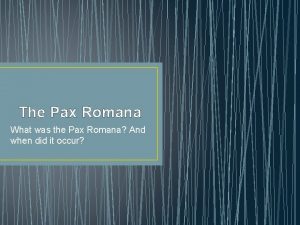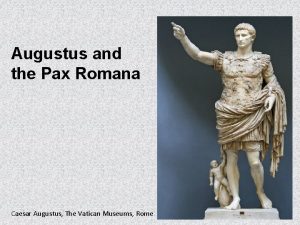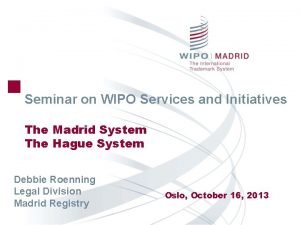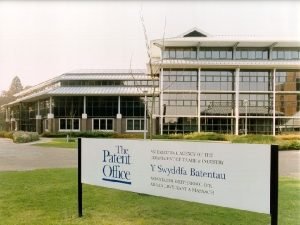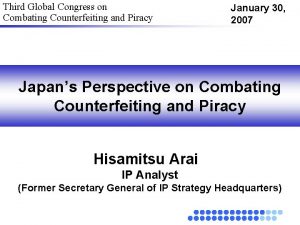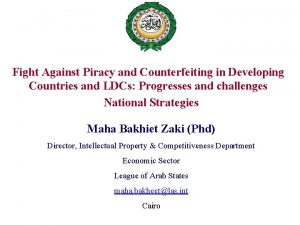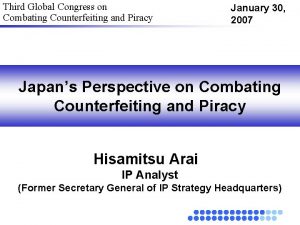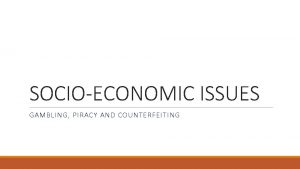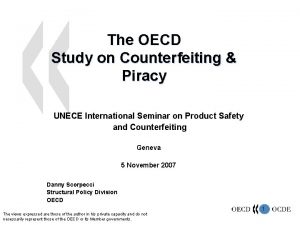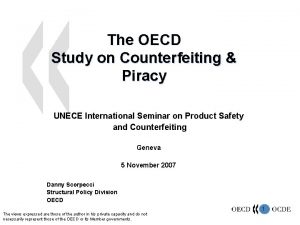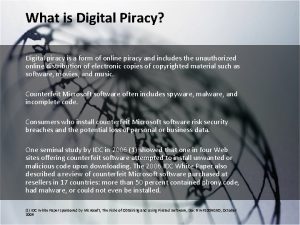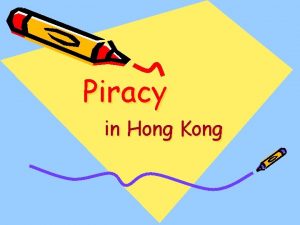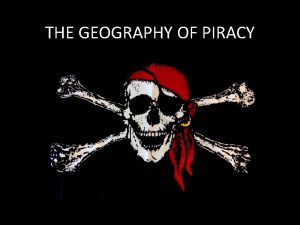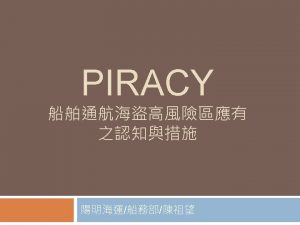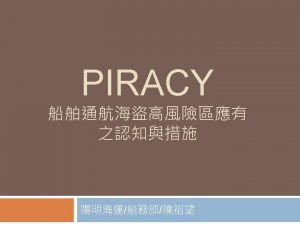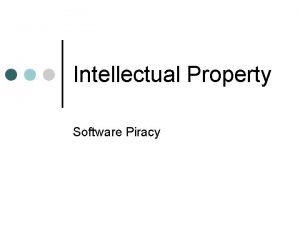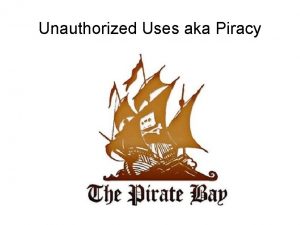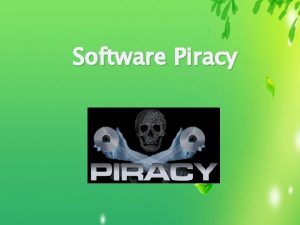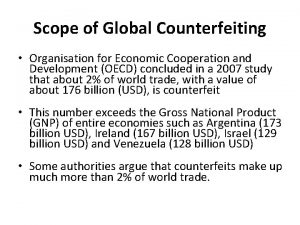The Economic Impact of Counterfeiting and Piracy Madrid



























- Slides: 27

The Economic Impact of Counterfeiting and Piracy Madrid – 26 February 2009 Hisashi Yoshikawa Deputy Directorate for Science, Technology and Industry OECD Danny Scorpecci Principal Economist, Structural Policy Division Directorate for Science, Technology and Industry OECD The views expressed are those of the author in his private capacity and do not necessarily represent those of the OECD or its Member governments.

The OECD Project Impact of innovation processes on growth and social welfare • Innovation is an important goal for policymakers Innovation important as: • a long run objective to stimulate growth • one of the responses in this time of economic crisis

The OECD Project Innovation processes are complex and there is a need for trends, evidence, analyses and guidelines. • OECD Innovation strategy formulates some innovation enhancing recipes. Intellectual property -- foundation and fuel for innovation in the time of knowledge economy • Importance of studies on IP infringements; scale, effects, mechanisms

The OECD Project Economic Impact of Counterfeiting and Piracy Phase 1: Counterfeit and pirated products • Tangible products that infringe trademarks, copyrights, patents or design rights, report published in May 2008 Phase 2: Digital piracy • With Governments for final approval. We hope it will be released shortly. Some preliminary points will be touched on in this presentation. Phase 3: Other IPR infringements • To be scoped and funded.

Phase I The Economic Impact of Counterfeiting and Piracy Tangible products that infringe trademarks, copyrights, patents or design rights. • Magnitude of the problem • Effects of counterfeiting and piracy • Market analysis • Government and industry initiatives • Sectoral case studies

phase I counterfeit and pirated products Sectoral case studies Sectors studied in depth Other sectors considered • • automotive products food/drink products pharmaceuticals tobacco products music recordings motion pictures and other video content • electrical components (including batteries) • • luxury goods, perfumes and fashion clothes chemicals and pesticides sportswear and other branded clothing personal care, toiletry and household products books industrial and consumer motor lubricants aircraft components toys computer software

phase I counterfeit and pirated products Magnitude of the problem • Measurement needs rigorous methodology, but data is hard to find • activities are illicit and clandestine • enforcement and customs data are sparse, incomplete and inconsistent • enterprises may be reluctant to divulge data • Analysis showed that international trade in counterfeit or pirated products could have been up to US$ 200 billion in 2005 The figure does not include – domestically produced and consumed products – non-tangible pirated digital products If added, the figure could be several hundred billion dollars higher • Earlier figure of 5 -7% of world trade was ill-defined, lacked rigorous foundation and could not be confirmed or disproved

phase I counterfeit and pirated products Extent of the problem • Virtually everything can (and probably has) been counterfeited, and is taking place in virtually every economy Analysis confirms counterfeiting of • increasingly complex products • sophisticated packaging • security items (i. e. holograms) • Growing trend towards everyday products intended to deceive consumers, many of which may affect public health and safety, eg • car parts • Pharmaceuticals • food/drink • Evidence of growing infiltration of legitimate supply chains – an area of interest to organised crime

phase I counterfeit and pirated products Customs seizures Seizures of imported counterfeit and pirated products from the top 20 source economies

phase I counterfeit and pirated products What drives the demand/supply of C&P, ?

phase I counterfeit and pirated products Main Effects Counterfeiting and piracy… • • • can impact negatively on innovation and growth may reduce employment where originals are produced can reduce foreign direct investment (FDI) where C&P takes place damages sales volume, profits, brand value and capitalisation of rights’ owners, and can lead to unwarranted potential legal liability can negatively affect consumer confidence can seriously affect health and safety of users evidence that legitimate supply lines are being infiltrated reduces tax revenues to governments induces high costs on governments and industry to combat C&P encourages participation by organised crime and corruption

phase I counterfeit and pirated products Outcomes: Distribution channels • Most counterfeited goods are transported through commercial transport services - often with appropriate documentation (such as Bills of Lading) • Growing use of transit points; - especially Free Trade Zones • The internet has emerged as a new and powerful means to sell via auction sites, stand alone e-commerce and e-mail solicitation

phase I counterfeit and pirated products Free Trade Zones (or Economic Processing Zones – EPZs) • FTZs have grown in importance in the context of counterfeiting and piracy • A definition of FTZs given in an OECD report* shows why: “a territorial or economic enclave in which goods may be imported, stored, repacked, manufactured and reshipped with a reduction in duties and/or minimal intervention by customs officials” * Export Processing Zones: Past and Future Role in Trade and Development, OECD 2007

phase I counterfeit and pirated products Counterfeiters use FTZs • Growing use of free trade zones - these are used as gateways and way-points where goods can be • broken down into smaller consignments • Documents sanitised to disguise point of manufacture • elaborated and repackaged (often goods only become counterfeits at this point) • transhipped to disguise actual origin • The lower intensity of customs surveillance in free trade zones can be to counterfeiters’ advantage

phase I counterfeit and pirated products Frequently used transit points for automotive parts

phase I counterfeit and pirated products Laws & regulations often ineffective • Not properly enforced • Insufficient public enforcement resources • Low priority in courts • Protection of locals • Courts often lenient because counterfeiting and piracy are not always considered to be serious crimes • Penalties don’t always deter

phase I counterfeit and pirated products Why is organised crime interested in C&P? • Profitability is high • Market is large • Demand is heavy • Risk of detection and prosecution is relatively low • Even if successfully prosecuted penalties low • Bribery, corruption and coercion can facilitate business and reduce risks

phase I counterfeit and pirated products Attributes of organised crime suitable for C&P • Resources to invest in production facilities • Can obtain templates, plans and originals for copying • Can create and maintain complex supply chains • Experience in smuggling • Can establish effective distribution/sales networks • Can infiltrate legitimate supply chains • Can protect operatives at all levels • Can use bribery/corruption/coercion

phase II digital piracy Phase II covers digital piracy of all copyrighted materials. • Pirate transactions that do not involve the use of physical media e. g. via Internet, LAN networks etc. • Numerous industries affected by digital piracy: music, movie, radio, television (including sports broadcasting), software (business and entertainment) • Many technical ways of market formation; most of them rely on solutions developed for legal purposes: Peer-to-peer networks (P 2 P), One-click hosting services, “Warez” sites, streaming services, leech sites, etc.

Why have different Phases to the study? This reflects very different markets for products covered • Phase I: addressed physical/tangible goods, hence: – fabrication facilities (hence investment), physical transportation/distribution, targeted markets, products attacked often mature • Phase II: addresses digital content, hence: – Virtually zero marginal cost of reproduction, no physical goods, digital delivery; broad markets, products attacked at point of greatest intrinsic value

phase II digital piracy Markets for pirated digital products Special economic properties: • Some pirated digital content appears to be offered to customers at almost zero price perhaps driven by non-monetary supply drivers • Some customers appear to pay for (pirated or legal) digital content even though they could acquire pirated alternatives for free (demand) Important role of “transaction costs“ for customers decisions

phase II digital piracy Possible market drivers Supply drivers • • • Attitude towards piracy Reciprocity mechanism Ease of distribution Profitability Legal and regulatory framework Demand drivers • • • Attitude towards piracy Availability Technical quality Low security awareness Ineffective enforcement

phase II - digital piracy Case Study – Sports Rights Owners Sector Market characteristics of live sports broadcasts • Internet streaming technology enables pirates to attack the live broadcast; when product has greatest value, • Potentially legitimate markets may not be covered by broadcasts and these may turn to illegitimate sources, • Distribution can be located off-shore to minimise detection – which delays/hinders redress, • Unlike physical fabrication facilities distribution facilities easy to re-establish even if closed down.

phase I counterfeit and pirated products Importance vs. Priority • Most governments have labelled counterfeiting and piracy as important problems. • However, not always matched by priority. Other illicit activities given first call on resources (drugs, people smuggling, gun running) • Governments may better respond to these problems if they appreciate the corrosive effects of C&P. – especially if full account taken of role of organised crime, the effects on health and safety, foregone tax revenue and weakened incentive to innovate

phase I counterfeit and pirated products Improving data collection • This study has highlighted just how poor data really is • Governments and industry can help by ensuring data is – systematically collected – comparable – Comprehensive • The reporting framework developed by the World Customs Organization (WCO) offers useful template for law enforcement agencies and industry

For the attention of policymakers • Improve co-ordination amongst domestic agencies • Consider having a clear C&P policy • Have a clear and enforceable legal and regulatory framework • Ensure effective enforcement • International co-operation where there are cross-border transactions, • Increase awareness amongst government officials and education of consumers • Enhance co-operation with industry • May be need to embrace new business models – especially in the digital market

For further information >>> Contact us Danny Scorpecci Directorate for Science, Technology and Industry OECD 2, rue André-Pascal 75775 Paris CEDEX 16 France Email: danny. scorpecci@oecd. org Phone: (+33) 1 4524 9433 Fax: (+33) 1 4430 6257 Website: www. oecd. org/sti/counterfeiting
 Piracy 101
Piracy 101 Forgery analysis
Forgery analysis Forensic handwriting analysis video
Forensic handwriting analysis video Baseline habits handwriting
Baseline habits handwriting Handwriting analysis forgery and counterfeiting
Handwriting analysis forgery and counterfeiting 12 handwriting characteristics
12 handwriting characteristics Pirated cd meaning
Pirated cd meaning Piracy
Piracy Vikings ere
Vikings ere Eli mufisovski
Eli mufisovski Anti counterfeiting trade agreement
Anti counterfeiting trade agreement Anti counterfeiting trade agreement
Anti counterfeiting trade agreement Scope of agribusiness
Scope of agribusiness Output sector in agribusiness
Output sector in agribusiness What is the scope and economic impact of agribusiness?
What is the scope and economic impact of agribusiness? What is the scope and economic impact of agribusiness?
What is the scope and economic impact of agribusiness? Positive impact of economic in tourism
Positive impact of economic in tourism What year did the pax romana begin
What year did the pax romana begin Caesar augustus pax romana
Caesar augustus pax romana Prof. meier and baldwin
Prof. meier and baldwin Economic growth vs economic development
Economic growth vs economic development Chapter 1 lesson 2 our economic choices worksheet answers
Chapter 1 lesson 2 our economic choices worksheet answers Wipo romarin madrid monitor
Wipo romarin madrid monitor Mayo 25 1888 el filibusterismo
Mayo 25 1888 el filibusterismo Hát kết hợp bộ gõ cơ thể
Hát kết hợp bộ gõ cơ thể Slidetodoc
Slidetodoc Bổ thể
Bổ thể Tỉ lệ cơ thể trẻ em
Tỉ lệ cơ thể trẻ em
